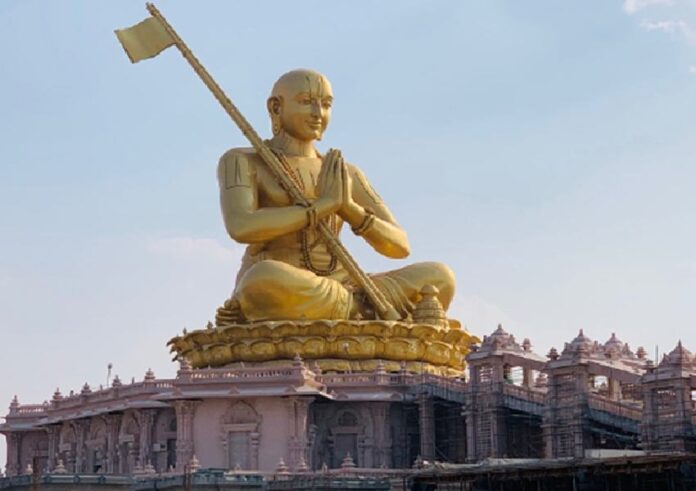The Statue of Equality, a gigantic statue of vedic saint Ramanujacharya, in the outskirts of Hyderabad. Who was Ramanujacharya? Why is it called the Statue of Equality? Let us know in this report.
The ‘Statue of Equality’, a gigantic statue of saint Ramanujacharya will be Unveiled by Prime Minister Narendra Modi on February 5 in the outskirts of Hyderabad.
Who was Ramanujacharya?
Born in 1017 in Sriperumbudur in Tamil Nadu, Ramanujacharya is revered as a Vedic philosopher and social reformer. He travelled across India, advocating equality and social justice.
Ramanuja revived the Bhakti movement, and his preachings inspired other Bhakti schools of thought. He is considered to be the inspiration for poets like Annamacharya, Bhakt Ramdas, Thyagaraja, Kabir, and Meerabai.
From the time he was a young budding philosopher, Ramanuja appealed for the protection of nature and its resources like air, water, and soil. He went on to write nine scriptures known as the navaratnas, and composed numerous commentaries on Vedic scriptures.
Ramanuja is also credited with establishing the correct procedures for rituals performed in temples throughout India, the most famous being Tirumala and Srirangam.
Why is it called the Statue of Equality?
Ramanuja was an advocate of social equality among all sections of people centuries ago, and encouraged temples to open their doors to everyone irrespective of caste or position in society at a time when people of many castes were forbidden from entering them.
He took education to those who were deprived of it. His greatest contribution is the propagation of the concept of “vasudhaiva kutumbakam”, which translates as “all the universe is one family”.
He travelled across India for several decades, propagating his ideas of social equality and universal brotherhood from temple podiums. He embraced the socially marginalised and condemned, and asked royal courts to treat them as equals. He spoke of universal salvation through devotion to God, compassion, humility, equality, and mutual respect, which is known as Sri Vaishnavam Sampradaya.
According to Chinna Jeeyar Swami, the Vaishnava seer behind the Statue of Equality, Ramanujacharya’s social philosophy was designed to cross the boundaries of the caste system and to embrace the whole of humanity.
“Ramanujacharya liberated millions from social, cultural, gender, educational, and economic discrimination with the foundational conviction that every human is equal regardless of nationality, gender, race, caste, or creed. We are celebrating his 1,000th birth anniversary as the ‘Festival of Equality’, upholding the view that the world is one family, ‘vasudhaiva kutumbakam’,” Chinna Jeeyar has said.
Where is the statue located?
The 216-foot-tall statue, which was first proposed in 2018, is located at the 45-acre scenic Jeeyar Integrated Vedic Academy (JIVA) at Muchintal near Shamshabad on the outskirts of Hyderabad.
The statue was proposed and designed by Chinna Jeeyar. The rituals for the dedication of the statue started on Wednesday (February 2) with over 5,000 Vedic scholars performing a maha yajna that is said to be the world’s largest of its kind in modern times. #KhabarLive #hydnews







